MANAGEMENT ACCOUNTING TABLE OF CONTENTS
Added on 2020-01-28
31 Pages5755 Words459 Views
MANAGEMENT ACCOUNTING
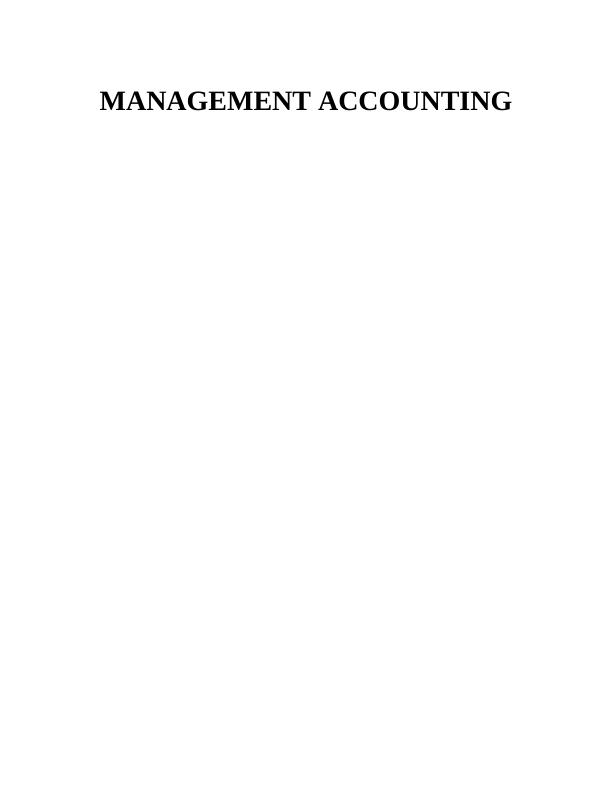
TABLE OF CONTENTSINTRODUCTION...........................................................................................................................4TASK 1............................................................................................................................................4(A) Significance and purpose of budgeting................................................................................4(B) Administrative procedure used in budgeting process ..........................................................4© Stages of budgeting process....................................................................................................5TASK 2............................................................................................................................................5(A) Classification of cost............................................................................................................5(B) Calculating fixed and variable costs.....................................................................................6TASK 3............................................................................................................................................7(A) Effect of absorption and marginal costing on inventory valuation......................................7(B) Difference between job costing, batch costing and process as well as service costing........7(C ) Preparation of profitability statement on the basis of absorption costing............................8(D) Preparation of profitability statement on the basis of marginal costing...............................9TASK 4............................................................................................................................................9(A) Advice to KBC's BOD..........................................................................................................9b) (1) Calculation of contribution to sales ratio........................................................................10(2) Calculation of Break-even point..........................................................................................10(3) Calculation of required sales to earn target profit worth £90000........................................10c) Limited quantity of labor to 66000 hours.............................................................................11d) Further availability of 6000 labor hours...............................................................................11TASK 5..........................................................................................................................................12(a) Types of budgeting method.................................................................................................121) Direct material purchase.......................................................................................................122) Cash budget of KBC Ltd......................................................................................................123) Benefits of cash budget.........................................................................................................134) Advise to KBC Ltd's BOD....................................................................................................13TASK 6..........................................................................................................................................131) Flexed budget and variance determination...........................................................................132) Analysis of variance..............................................................................................................143) Report to KBC Ltd's Board of Directors..............................................................................14TASK 7..........................................................................................................................................15A. Determining Break-even point and margin of safety...........................................................15B. Calculation of profit/Loss at 26500 pair of shoes................................................................16C. Determining sales to earn target profit ................................................................................16D. Determination of BEP units at advertisement campaign costs and higher selling price by15%...........................................................................................................................................16E. Advise to Bata Ltd................................................................................................................17CONCLCUSION...........................................................................................................................17REFERENCES..............................................................................................................................18
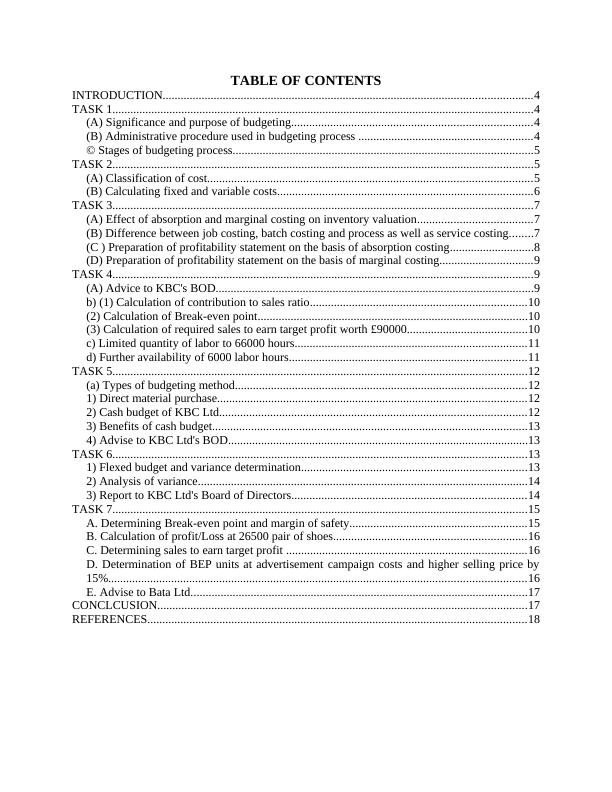
INDEX OF TABLESTable 1: Variable cost per unit.........................................................................................................6Table 2: North region ......................................................................................................................8Table 3: South region.......................................................................................................................8Table 4: South region ......................................................................................................................9Table 5: Contribution to sales ratio................................................................................................10Table 6: Calculation of Break-even point......................................................................................10Table 7: Calculation of required sales...........................................................................................10Table 8: Allotted labor hours.........................................................................................................11Table 9: Calculation of purchase of direct material.......................................................................12Table 10: Cash budget of KBC ltd.................................................................................................12Table 11: Variance in flexible budget............................................................................................13Table 12: Calculation of profit.......................................................................................................15Table 13: Calculation of BEP .......................................................................................................15Table 14: Calculation of profit/Loss at 26500 pair of shoes..........................................................16
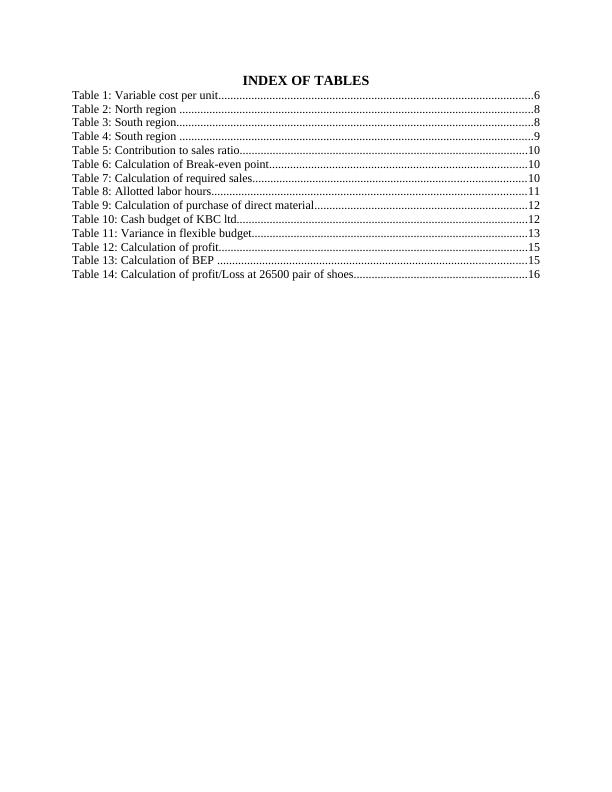
INTRODUCTIONManagement accounting is one of most important branch of accounting. Under this, thereare many techniques that can be used to identify firm weak and strong points. In this reportsignificance and purpose of budgeting are described in detail. Administrative proceduredescribed in the report is also discussed in the report. Along with this, stages of budgetpreparation process are discussed in detail. In the middle part of the report, costs are classifiedand their impact of absorption and marginal costing on inventory valuation and profitability isdiscussed in detail. At end of the report, break even analysis is done and suggestions are made inthe report.TASK 1(A) Significance and purpose of budgetingBudgeting have a lots of significance for the business firms because by using same topmanagers maintain stiff control on expenses of an organization. If expenses are kept in firm’scontrol then its profitability increases (Haiza Muhammad Zawawi and Hoque, 2010). The secondmain significance of budget is that firm on the basis of forecast prepare a plan regarding variousthings. Plan remain in theoretical form and in order to practically implement same some of thefigures are required to determine the extent to which managers needs to work in order tocomplete their objectives. These figures are arranged in systematic form which is known asbudget. While implementing a plan budget is used by the managers to do same accurately.Hence, it can be said that budget helps managers in successful execution of plan at minimumcost. Main purpose of preparing a budget is to motivate employees to work hard. In order toachieve budget objectives separate goals of each employee is decided in an organization (Lee,2011). Employees have to achieve these goals at any cost and this motivates employees to workhard. Hence, it can be said that budget is very helpful for an organization.(B) Administrative procedure used in budgeting process Under administrative procedure that is used to during budget preparation process first ofall middle level managers of an organization prepare a budget for the firm. While preparingbudget advice from different employees are taken and by considering their advice budget isprepared by the managers. After preparation of budget same is send to top management forapproval. In respect to this middle level managers that prepare a budget give presentation before
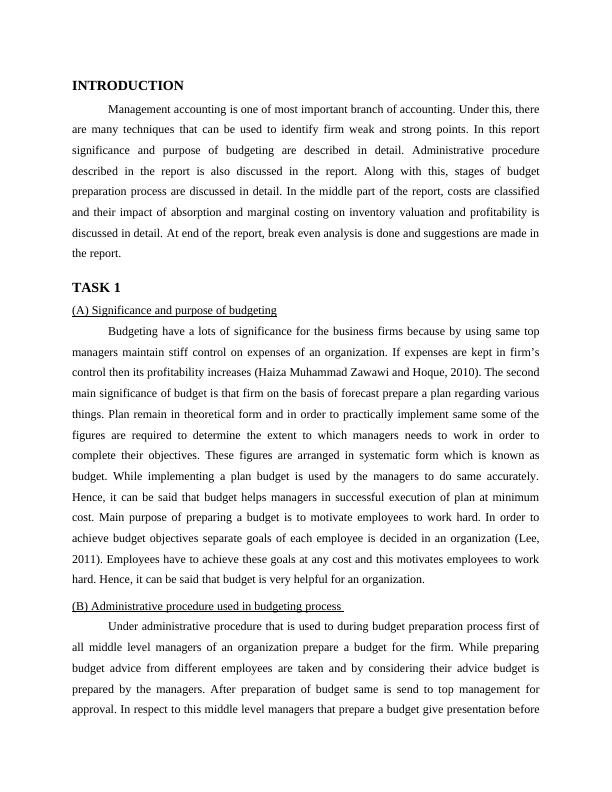
top managers. If top managers of an organization think that there is a need for improvement inthe budget than they make recommendation and same is followed by middle level managers inorder to bring changes in the budget (Angelakis, Theriou and Floropoulos, 2010). Hence, this isan administrative procedure that is used in budget process.c) Stages of budgeting processStages that are followed in budget preparation process are described below.Collection of data from different sources- Under this stage from different sources ofinternal information data is collected by the firm. This data is related to the past budgetsof the firm and actual performance that give on that budget. Hence, it can be said that it ispreliminary stage of budget preparation.Planning and preparation of draft budget- This is second important step of budgetpreparation process and under this planning is prepared about the way in which budgetwill be constructed by the managers (Englund and Gerdin, 2011). After preparing aproper plan, a budget is prepared by the managers and sent to the top managers.Approval on budget- In this step of budget, approval from top managers is obtained andin this regard budget is discussed by middle level managers with them. If top managerspropose any modification in budget then changes is done in same.Execution of budget- This is final stage under which budget is implemented at groundlevel by the managers through their subordinates (Burritt and Schaltegger, 2010). Anattempt is made in order to conduct all business activities within boundaries determinedby the budget.TASK 2(A) Classification of costCosts are divided below on the basis of following categories:Function- On the basis of function cost is divided on the basis of various functionaldepartments like production, HR and finance department. Cost of all these departments isadded to compute final cost of production for the firm.Nature- On the basis of nature cost is divided in to two categories namely direct andindirect cost. Direct cost included expenses that are related to production process of anorganization. On other hand, indirect expenses refer to the expenses that are not linked to
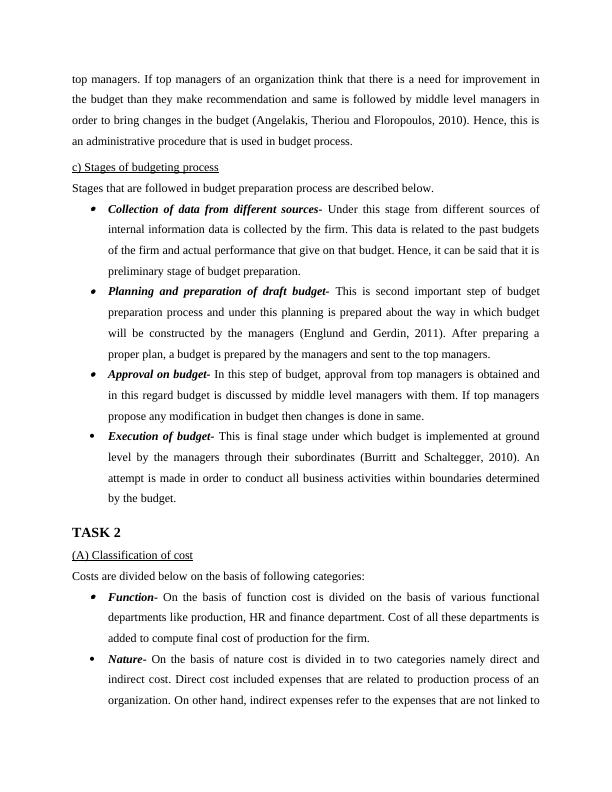
the production process of an organization. Purchase of raw material is example of directexpenses and transportation expenses are the best example of indirect expenses.Behavior- It divides cost on the basis of three categories namely fixed, variable and semi-variable cost. Fixed cost refers to the cost that remain same even production get changed.Purchase of machine is example of fixed cost. Variable cost is a cost that keeps onchanging with change in production level (Pitkänen and Lukka, 2011). Marketingexpenses are variable expenses. Semi-variable expenses are those whose some partremain static and some remain variable. Lease expenses are best example of semi-variable expenses.Illustration 1: Classification of cost(Source:Pitkänen and Lukka, 2011)

(B) Calculating fixed and variable costsHigh low method: This method pay a due attention on dividing cost of production. Costis a sum of fixed and variable expenses (Taipaleenmäki and Ikäheimo, 2013). It is very easy tocomprehend this method but same is unreliable. Due to simplicity of this method some ofmanagers use this method in their day to day practice.Variable cost per unit:Table 1: Variable cost per unitHighest costs56000lowest costs20000highest unit6100lowest unit2100Variable costs per unit= Highest costs – lowest costs/ highest unit – lowest unitVariable costs per unit= 56000-20000/6100-2100Variable costs per unit= 36000/4000Variable costs per unit= 9Total fixed costs: Highest costs – (Variable costs per unit*highest unit) = lowest costs – (Variable costs perunit*lowest unit)Total fixed costs= 56000-(9*6100) = 20000-(9*2100)Total fixed costs= 1100 The major aim behind making use of high-low method is that it acts as an aid in obtainingcost volume formula that is:y = a + bx = y = 1100 + 9xThe main limitation of high low regression analysis is that it is very simple to use but it does not produce reliable results.TASK 3(A) Effect of absorption and marginal costing on inventory valuationThe main difference between marginal and absorption costing is that in case of previouscost only variable expenses are included in computation of cost of production. Whereas, in case

of absorption costing only both type of cost are taken in to account for computing total cost ofproduction. Hence, it can be said that absorption method of costing help in proper valuation ofinventory then marginal costing because in former method all cost are included which are addedin computing cost of production (Li and et.al., 2012). In marginal costing all costs are notconsidered and due to this reason it does not value inventory in proper way. This is mainlimitation of this method. Variable expenses like raw material expenses is the best examplewhich is used in marginal costing method. Whereas, in latter method fixed cost is excluded.Hence, it can be said that absorption costing method helps in better valuation of inventory.Amount of profit in case of both methods are shown as absorption costing method and marginalcosting method. If inventory increases in firm then absorption costing method will show lessprofit. If inventory elevates then in case of marginal costing three will be higher profit. Hence,different profit is revealed by different method of costing.(B) Difference between job costing, batch costing and process as well as service costingJob costing- It is a costing method in which as per customer specification good areproduced. Hence, costing of each batch is done differently. In this all fixed and variablecosts are added to identify cost of each job.Batch costing- It is a method in which cost of each batch is computed by adding all fixedand variable expenses (Batch cost, 2016). The summed value of cost is divided by thenumber of units produced. By doing so per unit cost is computed under batch costingmethod.The main difference between job and batch costing is that in previous methodgoods are produced as per order of customers. But in latter method good are produced bythe firm according to its own discretion.Process costing- In this cost of each step of production process is identified and added.By doing so cost of production is computed by the manager under process costingmethod.Service costing- It is a costing method that is used by the firms that provide servicesinstead of producing goods (Christ and Burritt, 2013). Hence, this method of costing isdifferent from other methods of costing. The main difference between process costing isthat it is often used in manufacturing industry. Whereas, service costing is often used inservice industry.

End of preview
Want to access all the pages? Upload your documents or become a member.
Related Documents
Management Accounting and Budgeting Assignmentlg...
|22
|6816
|204
Accounting Techniques for Preparing Profit and Loss Statelg...
|26
|6654
|439
Business Finance: Calculation of Break-Even Point, Margins, and Profitlg...
|12
|2690
|257
Management Accounting | Decision Making Process | Reportlg...
|22
|5782
|85
Managing Finance and Cost in Business: A Case Studylg...
|10
|2148
|33
Business Financelg...
|10
|2492
|87
